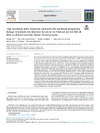Identificador persistente para citar o vincular este elemento:
https://accedacris.ulpgc.es/jspui/handle/10553/77303
| Título: | High broodstock fads2 expression combined with nutritional programing through broodstock diet improves the use of low fishmeal and low fish oil diets in gilthead seabream (Sparus aurata) progeny | Autores/as: | Xu, Hanlin Shajahan, Ferosekhan Turkmen, Serhat Afonso, Juan Manuel Zamorano, Maria Jesús Izquierdo, Marisol |
Clasificación UNESCO: | 310502 Piscicultura | Palabras clave: | Fatty Acyl Desaturase 2 N-3 Long-Chain Pufa Biosynthesis Nutritional Programming Plant Ingredients Utilization |
Fecha de publicación: | 2021 | Proyectos: | Consumer driven Production: Integrating Innovative Approaches for Competitive and Sustainable Performance across the Mediterranean Aquaculture Value Chain | Publicación seriada: | Aquaculture | Resumen: | One of the factors that limits the replacement of fish meal (FM) and fish oil (FO) by plant ingredients in diets for marine fish, is their lack of long chain-polyunsaturated fatty acids (LC-PUFA). LC-PUFA are essential fatty acids for these fish species, which lack sufficient fatty acyl desaturase 2 (Fads2) activity to synthesize them. Nutritional programing or the use of broodstock with a higher Fads2 activity could improve marine fish ability to synthesize LC-PUFA and their ability to use low FM and FO diets. The aim of this study was to determine the effect of gilthead seabream broodstock with inherently high or inherently low fads2 gene expression and nutritional programing with broodstock diets rich in FO or rapeseed oil (RO) on the progeny growth performance, liver morphology, biochemical composition and expression of selected genes. Sea bream juveniles (2.31± 0.01 g initial body weight, mean ± SD) obtained from broodstock with either high (H) or low (L) fads2 expression and fed a broodstock diet based on FO or RO were randomly distributed into 12 × 250 L tanks and nutritionally challenged for 45 days with a diet containing only 7.5% FM and no FO. The highest growth was found in juveniles from broodstock with a high fads2 expression and fed the RO diet, whereas the lowest growth was obtained in those from broodstock with a low fads2 expression and fed the RO diet. Juveniles from broodstock with high fads2 expression showed significantly higher fads2 expression in liver and increased PUFA contents in liver and muscle. Replacement of FO by RO in broodstock diets led to a significantly increased hepatic 18:3n-6/18:2n-6 ratio and reduction in the viscerosomatic index of the progeny juveniles, the hepatocyte size and the ghr-1/ghr-2 expression in muscle. Overall, the results showed significant trans-generational effects of both the broodstock fads2 expression and the type of lipid in the broodstock diet on the metabolism and performance of the juvenile progeny challenged with a diet low in FM and FO. | URI: | https://accedacris.ulpgc.es/handle/10553/77303 | ISSN: | 0044-8486 | DOI: | 10.1016/j.aquaculture.2020.736321 | Fuente: | Aquaculture [ISSN 0044-8486], v. 535, 736321 (Marzo 2021) |
| Colección: | Artículos |
Citas SCOPUSTM
8
actualizado el 08-jun-2025
Citas de WEB OF SCIENCETM
Citations
10
actualizado el 18-ene-2026
Visitas 5
355
actualizado el 10-ene-2026
Descargas
138
actualizado el 10-ene-2026
Google ScholarTM
Verifica
Altmetric
Comparte
Exporta metadatos
Los elementos en ULPGC accedaCRIS están protegidos por derechos de autor con todos los derechos reservados, a menos que se indique lo contrario.
